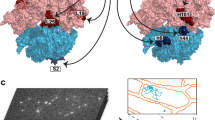Abstract
Ribosomal proteins and ribosomal associated proteins are complicated subjects to target and study because of their high conservation through evolution which led to highly structured and regulated proteins. Tagging of ribosomal proteins may allow following of protein synthesis in vivo and isolating translated mRNAs. HaloTag® is a new technology which allows detection in living cells, biochemical purification, and localization studies. In the present work, we tested HaloTag®-based ribosomal tagging. We focused on eIF6 (eukaryotic Initiation Factor 6 free 60S ribosomal marker), RACK1 (Receptor for Activated C Kinase 1; 40S and polysomes, not nuclear), and rpS9 (40S ribosomes, both in the nucleus and in the cytoplasm). Experiments performed on HEK293 cells included ribosomal profiles and Western blot on the fractions, purification of HaloTag® proteins, and fluorescence with time-lapse microscopy. We show that tagged proteins can be incorporated on ribosomes and followed by time-lapse microscopy. eIF6 properly accumulates in the nucleolus, and it is redistributed upon actinomycin D treatment. RACK1 shows a specific cytoplasmic localization, whereas rpS9 is both nucleolar and cytoplasmic. However, efficiency of purification varies due to steric hindrances. In addition, the level of overexpression and degradation may vary upon different constructs. In summary, HaloTag® technology is highly suitable to ribosome tagging, but requires prior characterization for each construct.





Similar content being viewed by others
References
Biffo S.; Sanvito F.; Costa S.; Preve L.; Pignatelli R.; Spinardi L.; Marchisio P. C. Isolation of a novel beta4 integrin-binding protein (p27(BBP)) highly expressed in epithelial cells. J Biol Chem 272: 30314–21; 1997.
Ceci M.; Gaviraghi C.; Gorrini C.; Sala L. A.; Offenhauser N.; Marchisio P. C.; Biffo S. Release of eIF6 (p27BBP) from the 60S subunit allows 80S ribosome assembly. Nature 426: 579–584; 2003.
Cox E. A.; Bennin D.; Doan A. T.; O’Toole T.; Huttenlocher A. RACK1 regulates integrin-mediated adhesion, protrusion, and chemotactic cell migration via its Src-binding site. Mol Biol Cell 14: 658–669; 2003.
Coyle S. M.; Gilbert W. V.; Doudna J. A. Direct link between RACK1 function and localization at the ribosome in vivo. Mol Cell Biol 29: 1626–1634; 2009.
Gandin V.; Miluzio A.; Barbieri A. M.; Beugnet A.; Kiyokawa H.; Marchisio P. C.; Biffo S. Eukaryotic initiation factor 6 is rate-limiting in translation, growth and transformation. Nature 455: 684–688; 2008.
Grosso S.; Volta V.; Vietri M.; Gorrini C.; Marchisio PC.; Biffo S. Eukaryotic ribosomes host PKC activity. Biochem Biophys Res Commun 376: 65–69; 2008.
Leippe D. M.; Zhao K. Q.; Hsiao K.; Slater M. R. Cell-free expression of protein kinase A for rapid activity assays. Anal Chem Insights 5: 25–36; 2010.
Lindstrom M. S.; Zhang Y. Ribosomal protein S9 is a novel B23/NPM-binding protein required for normal cell proliferation. J Biol Chem 283: 15568–15576; 2008.
McCahill A.; Warwicker J.; Bolger G. B.; Houslay M. D.; Yarwood S. J. The RACK1 scaffold protein: a dynamic cog in cell response mechanisms. Molecular pharmacology 62: 1261–1273; 2002.
Miluzio A.; Beugnet A.; Volta V.; Biffo S. Eukaryotic initiation factor 6 mediates a continuum between 60S ribosome biogenesis and translation. EMBO Rep 10: 459–465; 2009.
Nilsson J.; Sengupta J.; Frank J.; Nissen P. Regulation of eukaryotic translation by the RACK1 protein: a platform for signalling molecules on the ribosome. EMBO Rep 5: 1137–41; 2004.
Pascale A.; Alkon D. L.; Grimaldi M. Translocation of protein kinase C-betaII in astrocytes requires organized actin cytoskeleton and is not accompanied by synchronous RACK1 relocation. Glia 46: 169–182; 2004.
Ron D.; Jiang Z.; Yao L.; Vagts A.; Diamond I.; Gordon A. Coordinated movement of RACK1 with activated betaIIPKC. J Biol Chem 274: 27039–46; 1999.
Sanvito F.; Piatti S.; Villa A.; Bossi M.; Lucchini G.; Marchisio P. C.; Biffo S. The beta4 integrin interactor p27(BBP/eIF6) is an essential nuclear matrix protein involved in 60S ribosomal subunit assembly. J Cell Biol 144: 823–837; 1999.
Schoefl G. I. The effect of actinomycin D on the fine structure of the nucleolus. J Ultrastruct Res 10: 224–243; 1964.
Sengupta J.; Nilsson J.; Gursky R.; Spahn C. M.; Nissen P.; Frank J. Identification of the versatile scaffold protein RACK1 on the eukaryotic ribosome by cryo-EM. Nat Struct Mol Biol 11: 957–962; 2004.
Warner J. R. The economics of ribosome biosynthesis in yeast. Trends Biochem Sci 24: 437–40; 1999.
Acknowledgments
We thank Jacqui Mendez of Promega Corporation who assisted us with indications about Promega products and Cesare Covino of ALEMBIC (Advance Light and Electron Microscopy Bio Imaging Center) who took the images of fluorescence tagged cells. We thank Viviana Volta for reading the manuscript and for technical advice.
Author information
Authors and Affiliations
Corresponding author
Additional information
Editor: J. Denry Sato
Rights and permissions
About this article
Cite this article
Gallo, S., Beugnet, A. & Biffo, S. Tagging of functional ribosomes in living cells by HaloTag® technology. In Vitro Cell.Dev.Biol.-Animal 47, 132–138 (2011). https://doi.org/10.1007/s11626-010-9370-7
Received:
Accepted:
Published:
Issue Date:
DOI: https://doi.org/10.1007/s11626-010-9370-7




